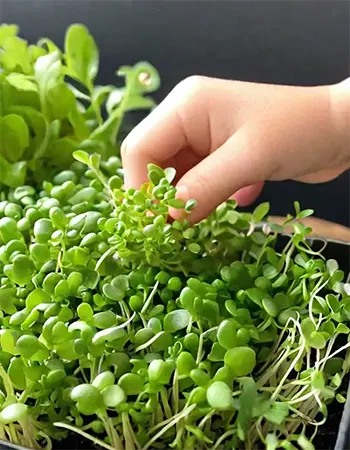Microgreens for Kids: Fun and Easy Ways to Introduce Kids to Healthy Eating
Encouraging healthy eating habits in children can feel like an uphill battle. Between picky palates and the allure of sugary treats, parents often find themselves struggling to get their kids to embrace nutritious foods. However, microgreens offer a unique and engaging solution to this challenge.

Beyond the Plate: A Sensory Experience
The beauty of microgreens lies in their ability to engage children beyond simply eating. Exploring microgreens transforms healthy eating into a multi-sensory experience. Children can:
- See: Microgreens come in many shapes and colours sparking curiosity and fostering a connection with nature.
- Touch: Feel the soft texture of the delicate leaves, providing a tactile learning opportunity.
- Smell: Discover the unique aromas of different microgreens, piquing their interest and encouraging exploration.
- Taste: Experience a variety of flavors and textures firsthand, offering a fun and rewarding way to expand their palates.
Microgreens: A Gateway to Healthy Eating
Microgreens are like tiny flavor bombs, packing a concentrated punch of vitamins, minerals, and antioxidants into their small size. This translates to several benefits for children:
- Picky Eater Approved: The diverse range of flavors and textures in microgreens allows children to discover ones they enjoy, making them more receptive to trying new and healthy foods.
- Nutritional Powerhouse: Microgreens offer a concentrated dose of essential nutrients often lacking in a child's diet. They are particularly rich in vitamins A, C, K, and E, which are crucial for healthy growth and development.
- Fun and Customizable: The vibrant colors and playful shapes of microgreens add a touch of fun to any meal. Children can personalize their plates by choosing and adding different microgreens, fostering a sense of ownership and encouraging them to try new things.
By incorporating microgreens into your child's life, you're not just introducing them to healthy eating, you're creating a fun and engaging experience that ignites their curiosity, fosters a connection with nature, and sets them on a path toward a lifelong appreciation for healthy food choices.
What are microgreens?
Microgreens are the immature leaves of various vegetables, herbs, and even flowers. They are harvested just before or after the first true leaves have emerged, typically within 7-14 days of planting. Despite their size, microgreens are packed with more vitamins, minerals, and antioxidants than their mature counterparts.
A Rainbow of Flavors and Textures: Microgreens for Every Palate
The world of microgreens is a playground for curious taste buds. These tiny seedlings boast a diverse range of flavors and textures, offering an exciting introduction to healthy eating for children of all ages.
- Mild and Sweet: For children hesitant to try new things, pea shoots are a gentle introduction. Their sweetness and subtle pea flavor are familiar and comforting, making them a win for even the pickiest eaters.
- Nutty and Fun: Sunflower microgreens add a delightful crunch and a subtle nutty flavor to any dish. Their large, round cotyledons (seed leaves) are easy for little hands to hold and "much" on, making them a fun and engaging way to experience the joy of healthy eating.
- Spicy Kick: For adventurous youngsters, radish microgreens offer a mild, peppery kick that tickles the taste buds. Introduce them in small quantities to gauge your child's tolerance and allow them to discover the exciting world of spicier flavors.
- Peppery and Zesty: Arugula microgreens pack a slightly peppery punch, adding depth and complexity to any dish. Their vibrant green color and slightly spiky texture make them visually appealing and encourage children to explore their unique taste profile.
This is just a glimpse into the diverse flavor spectrum of microgreens. From the tangy bite of mustard to the grassy notes of wheatgrass, there's a microgreen out there to suit every child's taste preference. By offering a variety of options, you encourage them to experiment and discover the flavors they enjoy, making healthy eating a fun and rewarding experience.
Nutritional Powerhouses in Tiny Packages: Microgreens Supercharge Your Child's Health
While microgreens may appear small and unassuming, they are packed with a nutritional punch that far exceeds their size. These miniature marvels are concentrated sources of essential vitamins and minerals, offering a powerful boost to your child's health and development:

- Vitamin A: Often referred to as the "vision vitamin," vitamin A plays a critical role in maintaining healthy eyesight. It also supports cell growth throughout the body and strengthens the immune system to fight off infections. Studies suggest that microgreens, particularly those from the Brassica family (broccoli, kale, etc.), can contain up to 40 times more vitamin A than their mature counterparts per gram.
- Vitamin C: This powerful antioxidant shields cells from damage caused by free radicals, protecting against chronic diseases. Vitamin C also plays a vital role in maintaining healthy skin and bones. Microgreens, especially sunflower and pea shoots, are excellent sources of vitamin C, offering significantly higher levels compared to mature vegetables.
- Vitamin K: This essential vitamin is crucial for blood clotting and bone health. Deficiencies in vitamin K can lead to excessive bleeding and increased risk of fractures. Microgreens, particularly those in the Brassica and Asteraceae (lettuce, sunflower) families, are abundant in vitamin K, contributing to healthy blood clotting and strong bones in growing children.
- Vitamin E: Another key antioxidant, vitamin E safeguards cells from oxidative stress and supports a robust immune system. Studies have shown that microgreens can contain higher levels of vitamin E compared to their mature counterparts, offering an extra layer of protection for your child's health.
Beyond the individual benefits of these essential vitamins, microgreens are also rich in other important nutrients, including:
- Minerals: Essential for various bodily functions, microgreens offer a good source of minerals like calcium, iron, and magnesium, which are crucial for healthy bones, blood production, and muscle function.
- Dietary Fiber: Microgreens contribute to a healthy digestive system by providing dietary fiber, which promotes regularity and gut health.
By incorporating microgreens into your child's diet, you're not just adding a pop of color and flavor to their meals, you're providing them with a nutritional powerhouse that supports their overall health and well-being in a delicious and fun way.
Fun and Creative Ways to Get Your Kids on Board with Microgreens
The possibilities are endless when it comes to incorporating microgreens into your child's diet. Here are some fun and creative ways to get them excited about these tiny nutritional powerhouses:
Elevate Familiar Favorites:
- Sprinkle them on: Transform everyday meals like sandwiches, omelets, pizzas, and salads into nutrient-packed delights by adding a sprinkle of microgreens. Choose milder varieties like pea shoots or sunflower microgreens for a gentle introduction, or let adventurous eaters explore peppery radish or tangy mustard greens.
- Pizzazz up their plate: Liven up pasta dishes, quesadillas, or nachos by adding a handful of microgreens for a burst of flavor and color. Encourage your child to create their own "microgreen masterpieces" by letting them choose and arrange different microgreens on their plate.

Get Creative in the Kitchen:
-
Blend them in: Sneak microgreens into their favorite smoothies or dips. Their subtle flavors are easily masked by fruits and vegetables in smoothies, while a sprinkle of microgreens adds a delightful texture and extra nutrients to dips and spreads.
-
Garnish with a flourish: Elevate soups, yogurt parfaits, or even oatmeal with a vibrant microgreen garnish. This not only adds visual appeal but also injects a surprising pop of flavor in every bite.
-
Bake them into treats: For baking enthusiasts, explore incorporating microgreens into muffins, pancakes, or even quiche. Experiment with different varieties to discover unique flavor combinations and add a touch of green goodness to your baked goods.
-
Organize a microgreen taste test: Set up a tasting party with various microgreens. Encourage your child to explore different flavors and textures by letting them sample each microgreen on its own or paired with different foods. This interactive approach allows them to discover their preferences and make microgreens a fun part of mealtime.
By getting creative, you can transform microgreens into a fun and engaging way to introduce your child to a world of healthy eating. So, embark on a microgreen adventure with your little ones, and watch their love for nutritious food blossom!
Further reading - Rideau Lakes - Power microgreens! | More than just cat grass | Power Up Athletes | Partnering with chefs

